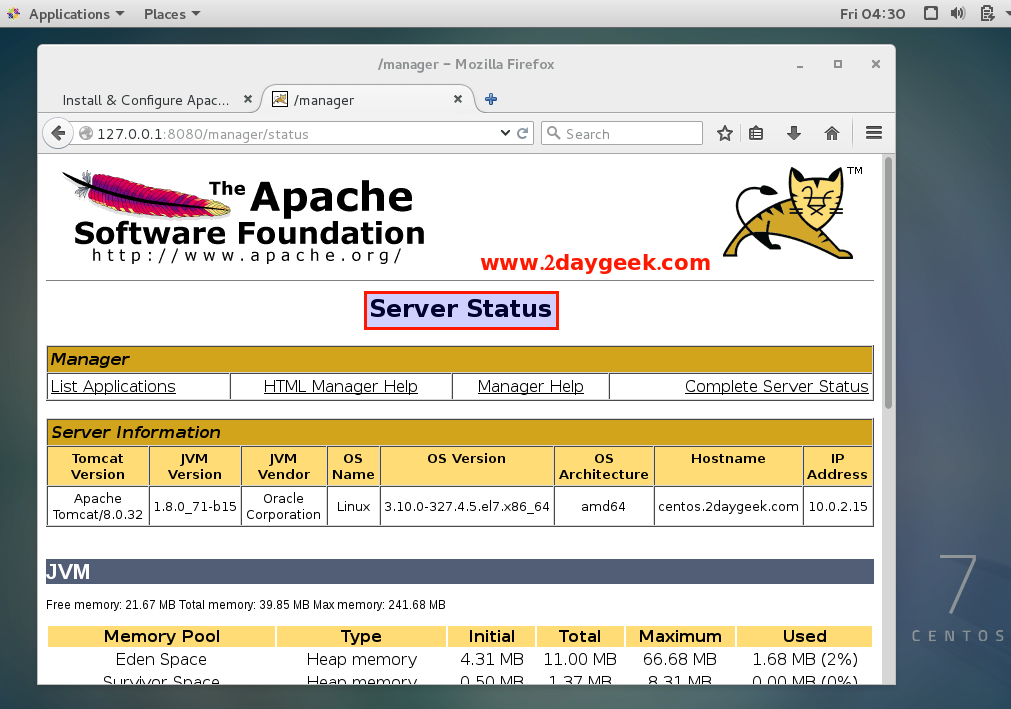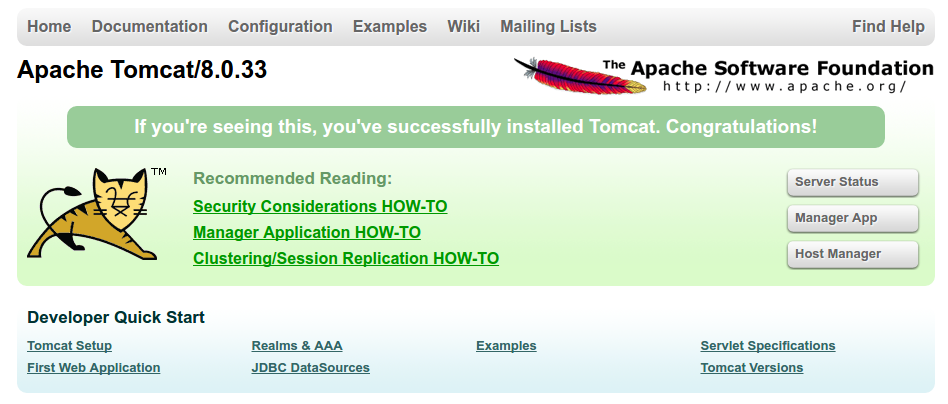Install Php On Tomcat 8 Manager
Posted : admin On 20.08.2019Running PHP applications in Apache Tomcat 7. But say you have a unique instance where you want to run both PHP and Java applications on Tomcat. Just install.
At first I want to explain the initial situation. Normally we use the Apache web server as HTTP server. With this you can run static content (like html, htm and so on) or you can run different script languages (like PHP, Perl, ). When we need Java support, we can install Tomcat on top of Apache. Usually the Tomcat server communicates on a different Port than the Apache web server (usually Port 8081).

With that configuration we can display our JSP, JSF and Servlets with domainname:8081. The problem was, that my homepage was built with Java.
This application should be displayed without the need to use the Tomcat port. But I have also different PHP applications, which also should be used with my domain. After some investigation I found a pretty good solution.
If you want to see this in action, check my. Configuration We assume, that the Apache web server is correctly installed and runs.
You can find a tutorial for this at my article ‘‘. There are some steps that have to be done:. install Tomcat For example with this command: apt-get install tomcat7 tomcat7-admin.
activate modproxy ModProxy is an apache module and routes requests to other web servers or addresses. You can activate it with: a2enmod proxy a2enmod proxyhttp.
configure Modproxy. Before this you may restart your Apache. You can define the routing for requests at the http.conf file. For our example we route it to another port. Deploy your PHP program with Tomcat Now you have no possibility to send requests to your Apache web server, because all requests are routed to Tomcat. This means we need to enable Tomcat to deploy PHP applications. This is by far simpler than it sounds:.
download.war and deploy it with Tomcat manager. Tomcat creates a directory for each project (.war). You can find these directories in the webapps directory of Tomcat.
simply copy your PHP program to this directory you can also rename this directory to fits your needs. Index Site On a new installed Tomcat there is already an index site. This site can be found in the Tomcat manager and is called /.

In the webapps folder you can find it in the ROOT directory. You can easily change this index site. You only have to delete the / web application in the manager or the ROOT directory. If you now want to deploy a ned Java application as index site, you have do the following: simply rename your.war file to ROOT.war and deploy it.
Now the site index is you Java program. If you want to have a PHP index program, you simply need to install it with the JavaBridge and then rename the directory to ROOT. Advantages. all sites are now manageable by the Tomcat manager. you have an overview of the whole server with the Tomcat manager Disadvantages. you loose the features of an simple Apache If you really need that you can change the request routing so that only certain requests are rooted.
deploy an application with help of the Java Bridge is a little bit inconvenient What do you think? Software driver adaptador usb a serial steren. Who else use that technique?
Do you know other Pros or Cons? Wow, interesting idea. I have never tried JavaBridge on my Pi, because Tomcat uses a lot of memory! Sounds as if it works 😉 Do you have no memory problems after some days? I discovered many memory issues with Java applications on my server so I moved completely away from Java.
To answer your questiondo you have any additional information? I think it would be a good idea to check your logs for PHP error messages. I never ran into this issue. Isn’t it possible to install php-cgi with your packet manager? Hi, It is a very good post. I have something similar problem.
Running Php On Tomcat
I have a dashboard application written in PHP which now runs on a Apache HTTP web server. Thia application shows charts.
I have another web application (JSP,Servlet) which runs on a Tomcat server. Now if I want to embed the pages of the dashboard application in the 2nd application which runs in Tomcat, what should be the correct way to do that? I am thinking about the below two approaches – 1 – Run the two applications on two different servers as they are running now. Embed the page of the page of the dashboard app by using it’s url. 2 – Shift the PHP application from Apache to Tomcat and then internally do some tweaking so that it can be embedded to the JSP pages.
Introduction Apache Tomcat is an open-source web server and servlet container that is used to serve Java applications. It is developed by the Apache Software Foundation, written in Java and released under Apache License 2.0.
It is a top level project of the Apache foundation. Apache Tomcat currently implements Java Servlet, JavaServer Pages, Java Expression Language and Java WebSocket. Apache tomcat 8 has upgraded some features. Some of them are listed below:. Tomcat 8 requires JAVA 7 or Higher to work.

Tomcat 8 supports Java Servlet 3.1. Tomcat 8 supports JavaServer Pages 2.3. Tomcat 8 supports Java Unified Expression Language 3.0. Tomcat 8 supports Java WebSocket 1.0 In this tutorial, we'll learn how to install and configure latest release of Apache Tomcat 8 on CentOS 7 server. Requirements A server running CentOS v.
A static IP Address for your server. A non-root user account with sudo privilege set up on your server.
Install Tomcat 8 On Linux
Installing Java Before installing Tomcat, you will need to install Java Development Kit (JDK) on your system, so any Java web application code can be executed. To install OpenJDK 7 JDK using yum, run this command: sudo yum install java-1.7.0-openjdk-devel Finally, to verify if the Java installation was successful, run the following command: java -version The output should be similar to what is displayed below: java version '1.7.099' OpenJDK Runtime Environment (rhel-2.6.5.0.el72-x8664 u99-b00) OpenJDK 64-Bit Server VM (build 24.95-b01, mixed mode) Create Tomcat User Before proceeding with the Tomcat installation.
Tomcat Php Setup
First create a separate system user and group which will run the Tomcat server: First, create a new tomcat group: sudo groupadd tomcat Then create a new tomcat user with a home directory of /opt/tomcat and group tomcat by running the following command: sudo useradd -M -s /bin/nologin -g tomcat -d /opt/tomcat tomcat Download and Install Apache Tomcat Now, download the latest version of Tomcat 8 available at You can use wget to download the Tomcat 8 in /tmp directory. Cd /tmp sudo wget Now, extract the contents of the Tomcat archive you just downloaded to /opt and rename apache-tomcat-8.0.33 to tomcat. To do this, run the following command: cd /opt sudo tar -xvf /tmp/apache-tomcat-8.0.33.tar.gz sudo mv apache-tomcat-8.0.33 tomcat Next, setup proper ownership using the following commands: sudo chown -R tomcat:tomcat /opt/tomcat Create a systemd Service File Now, you will need to create a systemd file to run Tomcat as a service.